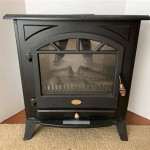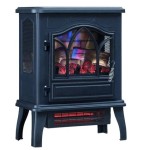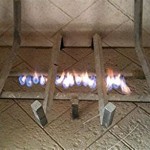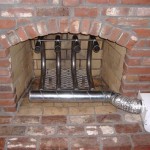Outdoor Stainless Steel Gas Fireplace Insert: A Comprehensive Guide
An outdoor stainless steel gas fireplace insert represents a sophisticated and practical addition to any outdoor living space. These inserts provide a clean-burning, aesthetically pleasing, and readily controllable source of heat and ambiance. Their durability, ease of use, and design versatility make them a popular choice for homeowners and businesses seeking to enhance their patios, decks, and other outdoor areas. This article delves into the key aspects of outdoor stainless steel gas fireplace inserts, covering their benefits, features, installation considerations, and maintenance requirements.
Durability and Aesthetics of Stainless Steel
The use of stainless steel in the construction of outdoor fireplace inserts is crucial for its resilience and visual appeal. Stainless steel, particularly grades 304 and 316, offers exceptional resistance to corrosion, rust, and the damaging effects of prolonged exposure to the elements. This is especially important in outdoor environments where rain, snow, sunlight, and fluctuating temperatures can rapidly degrade other materials. The non-porous nature of stainless steel also makes it easy to clean and maintain, preventing the buildup of grime and ensuring a consistently polished appearance.
Beyond its functional benefits, stainless steel contributes to the aesthetic versatility of the fireplace insert. Its sleek, modern look complements a wide range of architectural styles, from contemporary to traditional. The reflective surface of stainless steel can also enhance the brightness and visual appeal of the surrounding space, particularly when combined with decorative fire glass or ceramic logs. Furthermore, stainless steel can be finished in various ways, including brushed, polished, or powder-coated, to achieve a specific design aesthetic.
The longevity of stainless steel construction translates directly into a long-term cost savings for the owner. While the initial investment may be slightly higher than alternatives made from other materials, the reduced maintenance needs and extended lifespan offset this cost over time. This makes stainless steel a financially sound choice for those seeking a durable and visually appealing outdoor fireplace solution.
Key Features and Functionality
Outdoor stainless steel gas fireplace inserts are available with a variety of features that enhance their functionality and user experience. These features are often integrated into the design of the insert to ensure seamless operation and ease of use. Understanding these features is crucial for selecting the right insert for a specific outdoor space and user needs.
A primary feature is the type of ignition system employed. Common options include spark ignition, electronic ignition, and hot surface ignition. Spark ignition, the simplest and most affordable option, uses a piezo-electric spark to ignite the gas. Electronic ignition systems offer greater reliability and convenience, using an electronic control module to ignite the gas automatically. Hot surface ignition systems are known for their consistent and reliable performance, especially in windy conditions. The choice of ignition system depends on factors such as budget, desired level of convenience, and expected frequency of use.
Another important feature is the flame control mechanism. Most gas fireplace inserts offer adjustable flame height, allowing users to customize the heat output and visual effect. This control can be achieved through a simple valve or a more sophisticated electronic control panel. Some models also incorporate features such as thermostatic control, which automatically adjusts the flame height to maintain a desired temperature.
Safety features are paramount in outdoor gas fireplace inserts. These typically include a flame failure device (FFD), which automatically shuts off the gas supply if the flame is extinguished, preventing gas leaks. Some models also include pressure-relief valves to protect against over-pressurization and overheat sensors to prevent the unit from overheating. Adherence to relevant safety standards and certifications is a crucial consideration when selecting an outdoor gas fireplace insert.
The type of fuel used is also a key component of functionality. Most inserts operate on either natural gas or liquid propane (LP). Natural gas offers a readily available and often more economical fuel source for homes with existing natural gas lines. Liquid propane, on the other hand, offers greater flexibility in terms of placement, as it does not require a direct connection to a gas line. The choice between natural gas and LP depends on factors such as the availability of gas lines, the desired portability of the fireplace, and the cost of fuel in the specific location.
Installation Considerations and Safety Standards
Proper installation of an outdoor stainless steel gas fireplace insert is essential for ensuring safe and efficient operation. Installation must comply with all applicable local codes and regulations, and it is generally recommended to hire a qualified professional for the task. The installation process involves several key steps, each of which requires careful attention to detail.
The first step is to select a suitable location for the fireplace insert. The location should be well-ventilated and free from obstructions that could impede airflow or create a safety hazard. It should also be located a safe distance from combustible materials, such as wooden decks, fences, and overhanging structures. The manufacturer's instructions will specify the minimum clearance requirements for the specific model of fireplace insert.
The next step is to prepare the installation site. This may involve constructing a supporting structure, such as a concrete pad or a frame made of non-combustible materials. The supporting structure must be level and capable of supporting the weight of the fireplace insert. It is also important to ensure that the installation site provides adequate access for gas line connections and maintenance.
Connecting the gas line is a critical step that must be performed by a qualified professional. The gas line must be properly sized and installed in accordance with local codes and regulations. Leak testing is essential after the gas line is connected to ensure that there are no gas leaks. The fireplace insert should also be properly grounded to prevent electrical shock.
Once the fireplace insert is installed and connected to the gas line, it is important to perform a thorough inspection to ensure that everything is functioning properly. This includes checking the ignition system, the flame control mechanism, and the safety features. The manufacturer's instructions should be consulted for specific testing procedures.
Adherence to safety standards is paramount throughout the installation process. The fireplace insert should be certified by a recognized testing laboratory, such as the American Gas Association (AGA) or Underwriters Laboratories (UL). These certifications indicate that the fireplace insert has been tested and meets established safety standards. It is also important to follow all of the manufacturer's instructions and safety precautions.
Besides physical safety, carbon monoxide (CO) safety should be considered. While outdoor fireplaces pose a lower risk of CO poisoning compared to indoor ones, proper ventilation is still essential to avoid any potential buildup of CO. Maintaining the recommended clearance around the fireplace and ensuring adequate airflow can minimize the risk.
Maintenance and Care Recommendations
Regular maintenance is essential for ensuring the continued performance and longevity of an outdoor stainless steel gas fireplace insert. Proper maintenance involves cleaning, inspecting, and servicing the various components of the fireplace insert.
Cleaning the fireplace insert is a relatively simple task that can be performed on a regular basis. The stainless steel surfaces can be cleaned with a mild detergent and water. Avoid using abrasive cleaners or scouring pads, as these can scratch the stainless steel. The burner and firebox should also be cleaned periodically to remove any debris or soot buildup. A soft brush or vacuum cleaner can be used for this purpose.
Inspecting the fireplace insert is also important for identifying any potential problems. Check the gas line connections for leaks, the burner for signs of corrosion or damage, and the ignition system for proper functioning. The manufacturer's instructions will provide specific guidance on what to look for during inspections.
Servicing the fireplace insert should be performed by a qualified professional. This may involve replacing worn or damaged parts, adjusting the gas pressure, or cleaning the burner. The frequency of servicing will depend on the usage of the fireplace insert and the specific recommendations of the manufacturer.
In addition to regular cleaning and inspection, it is also important to protect the fireplace insert from the elements when it is not in use. A cover can be used to protect the fireplace insert from rain, snow, and sunlight. This will help to prevent corrosion and extend the life of the unit.
For models that utilize fire glass or decorative logs, periodic cleaning or replacement may be necessary to maintain the desired aesthetic. Fire glass can accumulate soot and debris over time, which can dull its appearance. Decorative logs can also become damaged or discolored with prolonged use.
By following a regular maintenance schedule, users can ensure that their outdoor stainless steel gas fireplace insert remains in good working order and continues to provide years of enjoyment.
Understanding the features, installation process, and maintenance requirements associated with outdoor stainless steel gas fireplaces is essential for making an informed decision. Considering all these aspects allows for the selection of a product that not only enhances the aesthetic appeal and functionality of an outdoor space but also operates safely and efficiently for years to come.

Superior 42 Stainless Steel Outdoor Propane Gas Fireplace Vre4342 The

Outdoor Vent Free 36 Complete Gas Fireplace Stainless Steel With Remote Control Vre3200 Vre3236

Outdoor Fireplace Stainless Steel Complete Vent Free 36 By Superior Vre4300 Series Vre4336

Majestic Courtyard 42 Traditional Outdoor Gas Fireplace Odcoug North Country Fire

Napoleon Riverside 42 Clean Face Outdoor Gas Fireplace Gss42cfn The

Superior 42 Inch Stainless Steel Outdoor Gas Fireplace Fine S

Superior Vre4236 36 Outdoor Indoor Firebox White Herringbone Vre Fireplaces Usa

Outdoor Vent Free 36 Complete Gas Fireplace Stainless Steel With Remote Control Vre3200 Vre3236

Empire Rose Outdoor Premium Gas Fireboxes Milliviolt Starwood Fireplaces

Empire Outdoor 36 Inch Stainless Steel Electronic Ignition Fireplace With Logs Op36fb2mf Olx24wr Oni24 Hvacdirect Com
Related Posts








